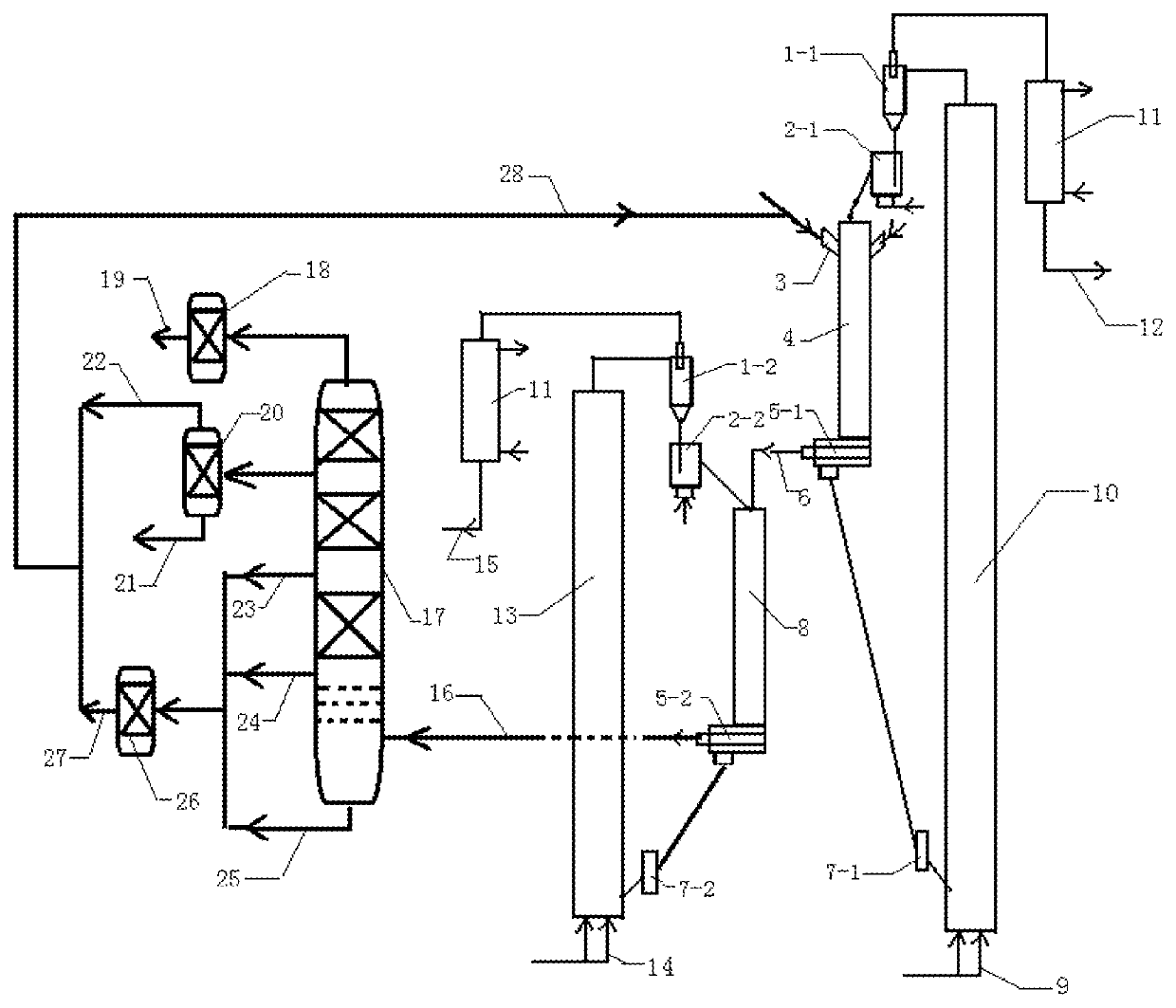Process of maximizing production of chemical raw materials by gaseous phase catalytic cracking crude oil with multi-stages in milliseconds in combination with hydrogenation
a gaseous phase catalytic cracking and crude oil technology, applied in the field of maximizing can solve the problems of low yield and selectivity of three olefins, the relative deficiency of light weight cracking raw materials, and the rapid growth of the worldwide market demand for low-carbon olefins, so as to reduce the influence of heat and mass transfer, maximize the production of chemical raw materials, and improve the yield and selectivity of thr
- Summary
- Abstract
- Description
- Claims
- Application Information
AI Technical Summary
Benefits of technology
Problems solved by technology
Method used
Image
Examples
example 1
[0090]The crude oil treated in the example is the thickened oil from the Shengli Oil Field in China with a residual carbon content of 15%. The key property parameters are shown in Table 1:
[0091]
TABLE 1Density (kg / m3, 20° C.)1,012.8Viscosity (mm · s−1, 100° C.)471Residual carbon content15.0(wt. %)Carbon content (wt. %)85.6Hydrogen content (wt. %)7.4
[0092]The solid heat carrier is a calcium aluminate porous microspheres having a particle size ranging from 15 to 150 micrometers.
[0093]The cracking catalyst is ZSM-5 molecular sieve with a particle size ranging from 15 to 150 microns.
[0094]The hydrogenation catalyst is a composite of a nickel-based hydrogenation catalyst and a molecular sieve catalyst with a mass ratio of 2:1.
[0095]The process flow is as follows:
[0096]1) the thickened oil from the Shengli Oil Field preheated to 180° C. is sprayed from a feed inlet of a downflow modification reaction tube into an upper portion of the downflow modification reaction tube, the produced oil mi...
example 2
[0124]The crude oil treated in the example is the thin oil from the Shengli Oil Field. The key property parameters are shown in Table 2:
[0125]
TABLE 2Density (kg / m3, 20° C.)834.1Viscosity (mm · s−1, 100° C.)56Residual carbon content (wt. %)3.2Carbon content (wt. %)82.6Hydrogen content (wt. %)9.1
[0126]The solid heat carrier is aluminum silicate porous microsphere having a particle size ranging from 15 to 150 micrometers.
[0127]The cracking catalyst is ZSM-5 molecular sieve having a particle size ranging from 15 to 150 microns.
[0128]The hydrogenation catalyst is identical with that in Example 1.
[0129]The process flow is as follows:
[0130]1) the thin oil from the Shengli Oil Field preheated to 150° C. is sprayed from a feed inlet of a downflow modification reaction tube into an upper portion of the downflow modification reaction tube, the produced oil mist is mixed with a high temperature solid heat carrier (aluminum silicate porous microspheres) at a temperature 1,000° C. flowing downwar...
example 3
[0144]The crude oil processed in the example is identical with that in Example 1.
[0145]The solid heat carrier is the porous microsphere carrier loaded with alkali metal (Na), the porous microsphere carrier has a particle size ranging from 15 to 150 micrometers.
[0146]The cracking catalyst is a FCC molecular sieve catalyst having a particle size ranging from 15 to 150 micrometers.
[0147]The hydrogenation catalyst is identical with that in Example 1.
[0148]The process flow is as follows:
[0149]1) the thickened oil from the Shengli Oil Field preheated to 300° C. is sprayed from a feed inlet of a downflow modification reaction tube into an upper portion of the downflow modification reaction tube 4, the produced oil mist is mixed with a high temperature solid heat carrier (porous microsphere carrier loaded with Na) at a temperature 800° C. flowing downward from the first return controller for milliseconds, so as to heat, vaporize and pyrolyze the heavy oil, the pyrolysis reaction temperature...
PUM
| Property | Measurement | Unit |
|---|---|---|
| temperature | aaaaa | aaaaa |
| temperature | aaaaa | aaaaa |
| temperature | aaaaa | aaaaa |
Abstract
Description
Claims
Application Information
 Login to View More
Login to View More - R&D
- Intellectual Property
- Life Sciences
- Materials
- Tech Scout
- Unparalleled Data Quality
- Higher Quality Content
- 60% Fewer Hallucinations
Browse by: Latest US Patents, China's latest patents, Technical Efficacy Thesaurus, Application Domain, Technology Topic, Popular Technical Reports.
© 2025 PatSnap. All rights reserved.Legal|Privacy policy|Modern Slavery Act Transparency Statement|Sitemap|About US| Contact US: help@patsnap.com

